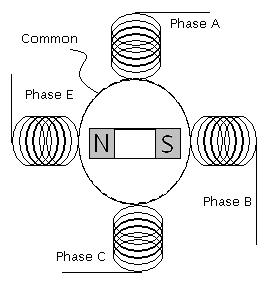The stepper motor is a motor that rotates in steps, unlike regular AC or DC motor that rotates continuously.
The stepper motor is expressed in terms of step size, for example, if a stepper motor specifies that the step size of 10 degrees, then it means that every step of the stepper motor is 10 degrees.
Here we will discuss about the unipolar stepper motor, before you start looking in the unipolar stepper motors, we will briefly discuss the different types of stepper motors:
1. Unipolar stepper motor
2. Bipolar stepper motor
These are usually available on the market, along with this we also have other types of stepper motors like multiphase steppers, etc., that are behind the scope of this article.
In general, the control of a unipolar stepper motor is simple because it is easy to control the current phase of each winding of stepper motor and you can observe the stepper motor rotating in one direction. But when it comes to bipolar stepper motor, you need to change the direction of current for each step. In other words, the current passing through each winging of the stepper motor will alternate for each step, is rotated by the stepper motor in one direction.
Now when it comes to control a unipolar stepper motor, first we must understand the internal circuitry of unipolar stepper motor.
I named each phase coils of Phase A, B, C and E with a common cable, this designation is not a rule, It just for an easy understanding of the circuit.
From the figure above, it’s clear that the stepper motor will have a minimum of 5 wires. Sometimes it can even be 6 wires in which there are two common wires. We just have to short the two common wires and take them as a common wire.
Now, using a common wire and the phase wire, you can rotate the stepping motor by supplying a source of voltage. As the power of each phase in sequence one after another, you can observe the stepper motor rotating in one direction.
For example, if you have a stepper motor with a step size of 10 degrees, then you have 360/10 = 36 steps to a complete revolution for the shaft of the stepper motor. This means you need to fire each phase separately one after another in a sequence of 36 times.
Step 1: Phase A Energize
Step 2: Phase B Energize
Step 3: Phase C Energize
Step 4: Phase E Energize
Step 5: Phase A Energize
Step 6: Phase B Energize
Step 7: .. ... ............
.... ... ......
.... ... ......
.... ... ......So on to step 36
Step 36: Phase E Energize
When finally complete the step 36, the shaft of the stepper motor has completed 360 degrees of rotation. By altering the firing sequence you can turn the motor forward and backward.
The activation process of a phase can be done by providing a voltage source to the phase wire and common wire. For example, if you want to fire phase A in stepper motor with a 5 V DC source, you can do by connecting the positive terminal of the voltage source to the common wire and the negative terminal phase A wire. You can even do the opposite, but since there are many integrated circuits of drivers available on the market that drives the stepper motor by sinking of the current, it would be better to have a common wire connected to the positive terminal of the voltage source.
Subscribe our NewsletterSubscribe to get lastest news for products and special offers!
Established in 1992, OSM Technology Co.,Ltd. began as a consulting company specializing in Stepper motor applications. Throughout its history, OSMTEC has continued to develop its capabilities in the areas of design engineering, manufacturing, and customer service. In 1995, OSMTEC expanded its operatings to include the manufacturing of its own Hybrid Stepper Motor. Since then, the company has developed its product line to include Linear Actuator and Brushless DC Motor.
Our operations are certified to ISO 9001:2000 and QS 9000. All products carry major approvals such as CE and ROSH. With OSMTEC Technology, you get the highest quality products, all made possible by the most dedicated people.
CONTACT
Email: [email protected]
Phone: (+86)574 28837284
Adress: No. 535, Renmin Road, Jiangbei District Ningbo CN 315000
15-4, #799 Hushan Rd., Jiangning District, Nanjing CN, 211100
Powered By OSMTEC © 2024

 CART
CART
.JPG)